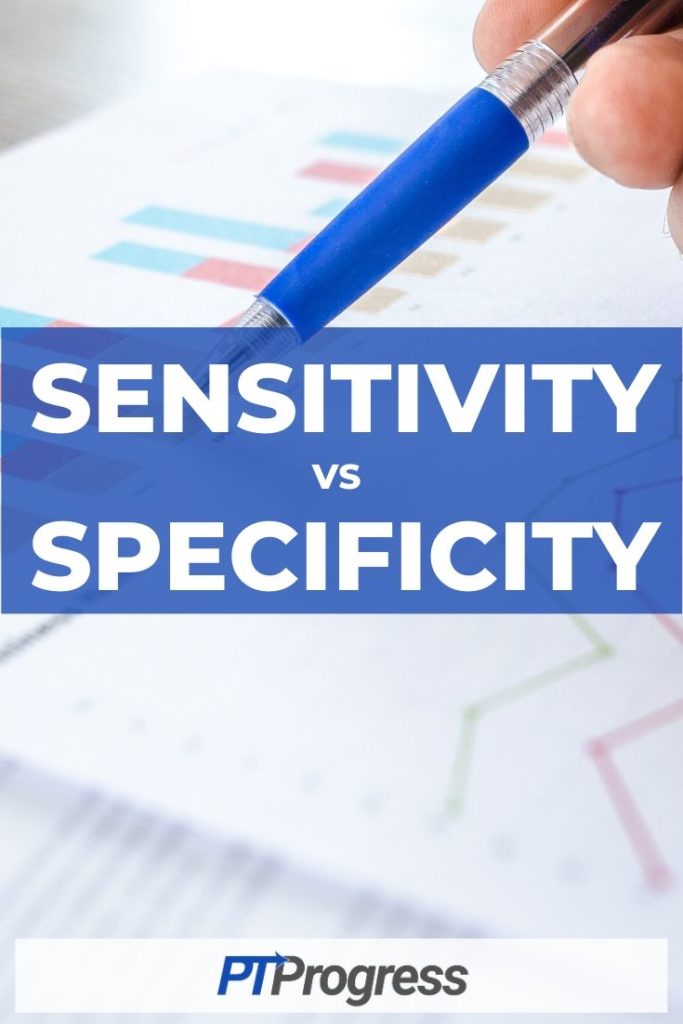
What is Sensitivity?
Sensitivity implies the ability of a test to identify the person who has a particular condition, dysfunction, or disease when they actually do (a true positive). Of ALL the people who have the disease or condition, what percentage will actually test positive for the disease?
For example, a test with a sensitivity ratio of 90% means that 90% of people with the disease will test positive using this diagnostic test (a true positive). The test will correctly identify 90% of people who have the disease. The other 10% of people still have the disease, they just tested negative (a false negative.)
Interpretation in practice: Tests with higher sensitivity are most useful in ruling out a pathology. (SnNout) “Sensitive test with a Negative result is good for ruling OUT a condition.
Ex. “This test has a high sensitivity which means it can detect people who have this disorder. People with this disorder usually test positive with this test. Since the result was negative, we can be confident in saying you do not have the condition. We can rule out this condition.
What is Specificity?
Specificity implies the ability of a test to identify the people who do not have a particular condition, dysfunction, or disease (a true negative). Of all the people who do not have the disease or condition, what percentage will actually test negative for the disease?
For example, a test with a specificity ratio of 95% means that 95% of people who do not have the disease will test negative using this diagnostic test (a true negative). The test will correctly identify 95% of people who do not have the disease. In this example, 5% of people may test positive for the disease, but don’t actually have the disease or pathology (this is a false positive).
Interpretation in practice: Tests with higher specificity are most useful for ruling in a pathology. (SpIn) Specific test with a Positive result is good for ruling IN a condition.
Ex. “This test has a high specificity, which means it can correctly identify people who do not have this disorder. If you do not have the disorder, we can be confident this test will return a negative finding. People who do not have this condition or disorder rarely have a positive finding with this test. Since the results were positive, we can be confident in saying you do have the condition. We can rule in this condition.
What are Likelihood Ratios
Likelihood ratios are useful for the interpretation of diagnostic tests. View it as a multiplier that may increase or decrease the odds (or likelihood) of a diagnosis.
Specificity and sensitivity values can be combined to formulate a likelihood ratio, which is useful for determining how the test will perform.
- A higher LR means the patient is more likely to have the disease.
- A lower LR means they probably do not have the disease.
Since test results can be either positive or negative, there are two types of likelihood ratios: Positive LR (+LR) and Negative LR (-LR)
Positive LR (+LR): tells us how much we can increase the probability that someone has a specific disease when they test positive.
Negative LR (-LR): tells us how much we can decrease the probability that someone has a disease when they test negative.
Simplified Take on LR:
+LR: A higher +LR is better for ruling a disease as more likely.
-LR: A lower -LR is better for ruling a disease as less likely.
Likelihood Ratio Interpretation
| +LR (Helps RULE IN a result as more likely) | Expected % Change in Post-Test Probability | Degree of Shift in Post-Test Probability |
| 1 – 2 | none/minimal | None |
| 2 – 5 | 15% increase | Small |
| 5 – 10 | 30% increase | Moderate |
| 10 | 45% increase | Large |
| -LR (Helps RULE OUT a result as less likely) | Expected % Change in Post-Test Probability | Degree of Shift in Post-Test Probability |
| < 0.1 | 45% decrease | Large |
| .1 – .2 | 30% decrease | Moderate |
| .2 – .5 | 15% decrease | Small |
| 0.5 – 1 | none/minimal | None |
For example, if a diagnostic test has a +LR of 4, there is about a 15% increase in the likelihood of the disease with a positive test.
If a diagnostic test has a -LR of .15, there is about a 30% decrease in the likelihood of the disease with a negative result.
Conclusion
Sensitivity and specificity can be confusing for someone new to research. I hope these examples were helpful and explain the concept in a way that makes a little more sense to you! The next time you look at special tests and review the specificity and sensitivity section, remember the acronym SPiN and SnNOUT!

